Animal Tissues, Organs & Systems
1/166
Earn XP
Description and Tags
Name | Mastery | Learn | Test | Matching | Spaced |
|---|
No study sessions yet.
167 Terms
What is the main function of the digestive system?
To digest food and absorb the nutrients obtained from digestion.
What is the role of the pancreas and the salivary gland in the digestive system?
The pancreas and the salivary gland are glands which produce digestive juices containing enzymes.
What is the role of the stomach in the digestive system?
Produces hydrochloric acid - which kills any bacteria present and provides the optimum acidic pH for the protease enzyme to function.
What is the role of the small intestine in the digestive system?
The small intestine is the site where soluble food molecules are absorbed into the bloodstream.
What is the role of the liver in the digestive system?
Produces bile (stored in the gallbladder) which emulsifies lipids and allows the lipase enzyme to work more efficiently.
What is the role of the large intestine in the digestive system?
Absorbs water from undigested food, producing faeces.
What is the role of enzymes in the digestive system?
Enzymes act as biological catalysts which speed up the rate of biological reactions (the breakdown of food) without being used up.
How does the shape of an enzyme affect its function?
Enzymes have a specific active site which is complementary to their substrate.
What is metabolism?
The sum of all the reactions in a cell or an organism.
What types of metabolic reactions do enzymes catalyse?
Building larger molecules from smaller molecules eg. glucose to starch.
Changing one molecule to another eg. glucose to fructose.
Breaking down larger molecules into smaller molecules eg. carbohydrates to glucose.
What is the lock and key hypothesis of enzyme function?
The shape of the enzyme active site and the substrate are complementary, so can bind together to form an enzyme-substrate complex.
How does temperature affect enzyme action?
Up to a certain point, increasing temperature increases enzyme action, as molecules have a higher kinetic energy.
Above a certain temperature, the shape of the active site is altered and the enzyme becomes denatured, so it can no longer catalyse the reaction.
The optimum temperature is around 37°.
How does pH affect enzyme function?
The optimum pH for most enzymes is 7 (apart from proteases in the stomach).
If the pH is too extreme, the shape of the active site may be altered and the enzyme may no longer work.
Where are carbohydrases, proteases and lipases produced in the body?
Carbohydrases: amylase - salivary gland and pancreas; maltase - small intestine.
Proteases: pepsin - stomach; others - pancreas and small intestine.
Lipases: pancreas and small intestine.
What is the role of carbohydrases in the digestive system?
Carbohydrases break down carbohydrates into monosaccharides and disaccharides.
Amylase breaks down starch into maltose, and maltase breaks down maltose into glucose.
What is the role of proteases in the digestive system?
Proteases break down proteins into amino acids.
What is the role of lipases in the digestive system?
Lipases break down lipids into fatty acids and glycerol.
How are the products of digestion used?
They are used to build bigger molecules such as carbohydrates and proteins.
Glucose is used as a substrate in respiration.
Where is bile made and stored in the body?
Bile is made by the liver and stored in the gallbladder.
What is the role of bile in the digestive system?
Bile is an alkaline substance which neutralises the hydrochloric acid secreted by the stomach.
Bile emulsifies lipids to form droplets - this increases the surface area for the lipase enzyme to work on.
What is the heart?
An organ that pumps blood around the body.
What is the purpose of the circulatory system?
Carries oxygen and other useful substances to bodily tissues, and removes waste substances.
How does the double circulatory system work?
One pathway carries blood from the heart to the lungs - where the gaseous exchange of oxygen and carbon dioxide takes place.
One pathway carries blood from the heart to the tissues.
Where does blood pumped by the right ventricle go?
The lungs
Where does blood pumped by the left ventricle go?
Body tissues
Why is the double circulatory system important?
It makes the circulatory system more efficient - for example, oxygenated blood can be pumped around the body at a higher pressure by the left ventricle.
How many chambers does the heart have and what are they called?
4 - right atrium, right ventricle, left atrium, left ventricle.
Why is the wall of the left ventricle thicker?
The left ventricle has to pump blood at a higher pressure around the whole body.
What are the four main blood vessels associated with the heart?
Aorta, Pulmonary vein, Vena cava, Pulmonary artery.
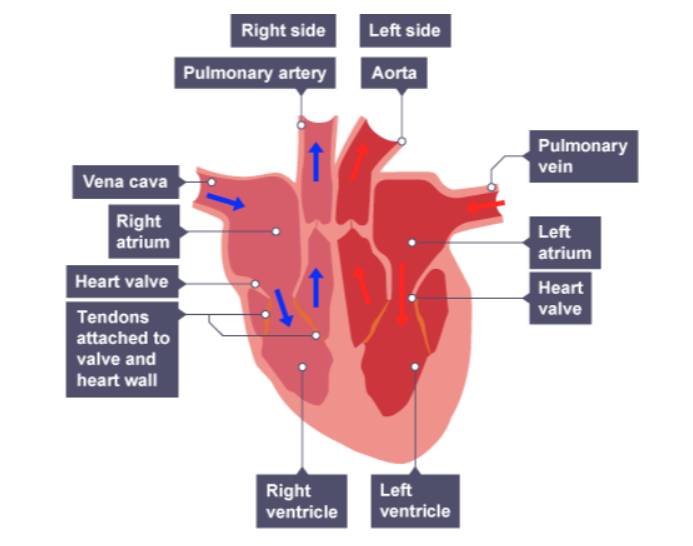
What side of the heart is the aorta on?
Left

What side of the heart is the pulmonary vein on?
Left

What side of the heart is the vena cava on?
Right

What side of the heart is the pulmonary artery on?
Right
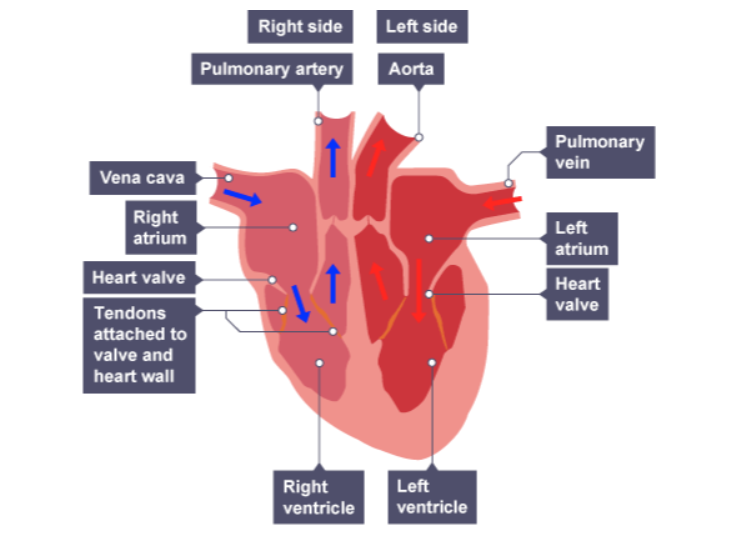
What does the aorta do?
It carries oxygenated blood from the heart to the body.
What does the pulmonary vein do?
It carries oxygenated blood from the lungs to the heart.
What does the vena cava do?
It carries deoxygenated blood from the body to the heart.
What does the pulmonary artery do?
It carries deoxygenated blood from the heart to the lungs.
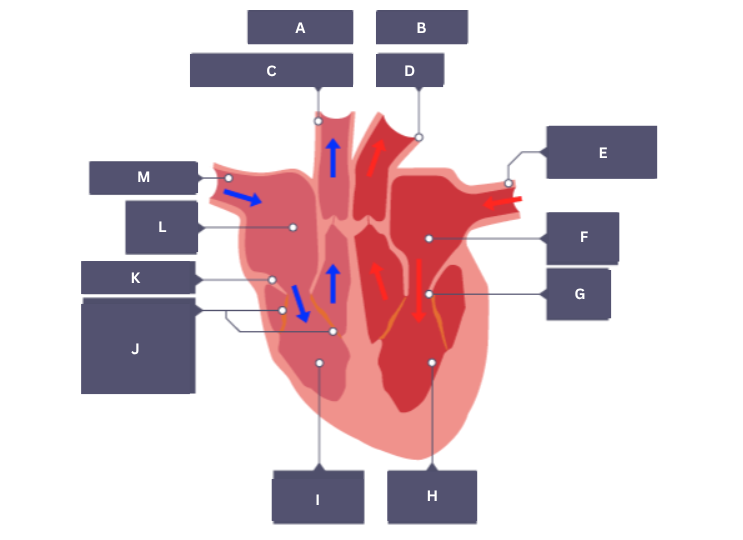
On this diagram of the heart, label A.
Right side
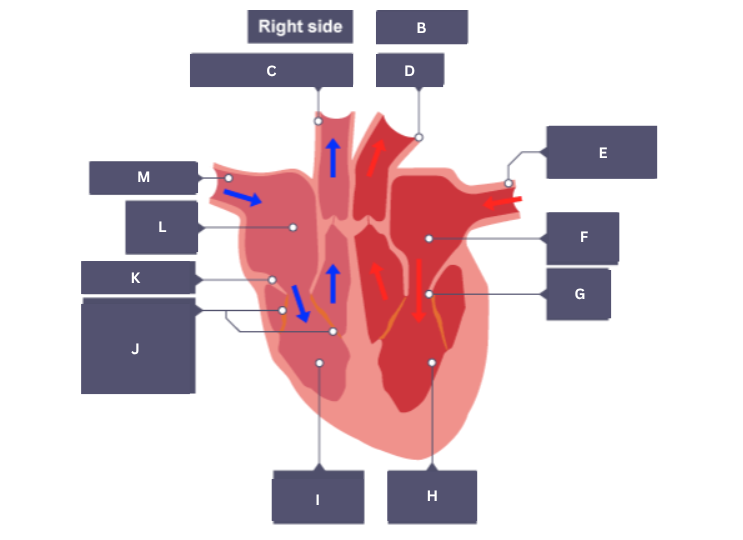

On this diagram of the heart, label B.
Left side
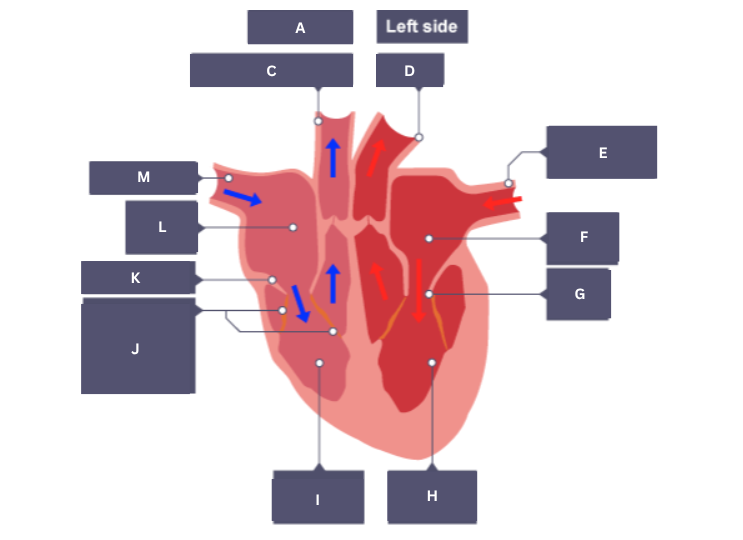
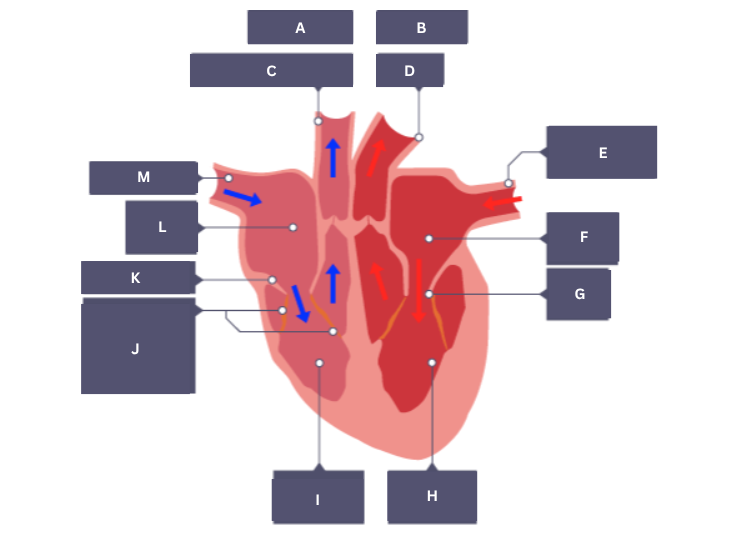
On this diagram of the heart, label C.
Pulmonary artery
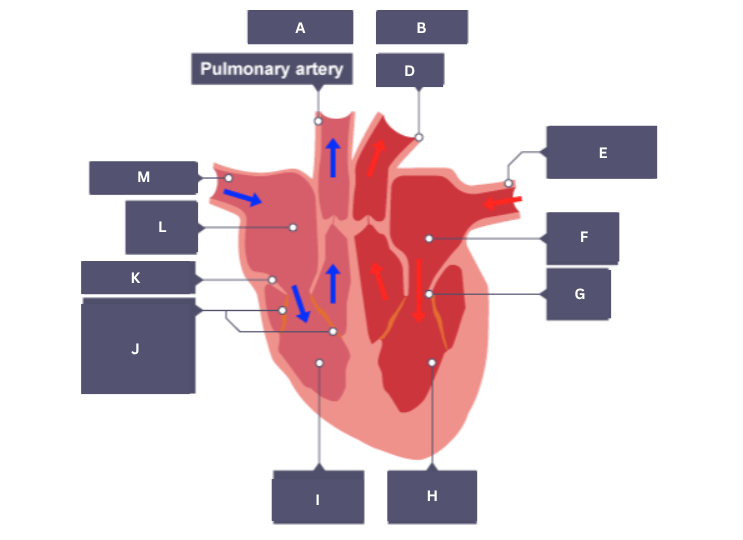

On this diagram of the heart, label D.
Aorta
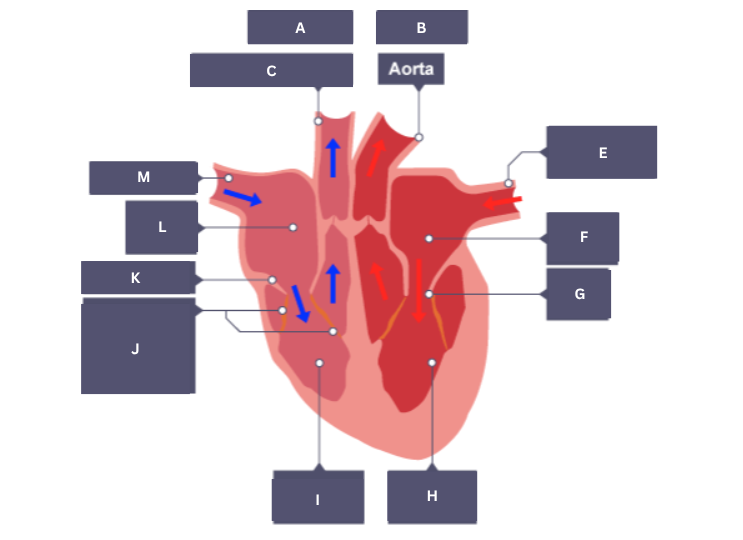
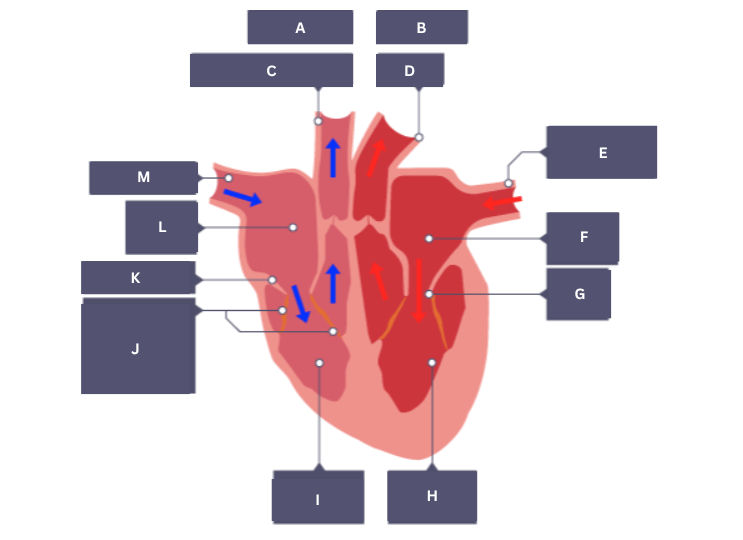
On this diagram of the heart, label E.
Pulmonary vein


On this diagram of the heart, label F.
Left atrium

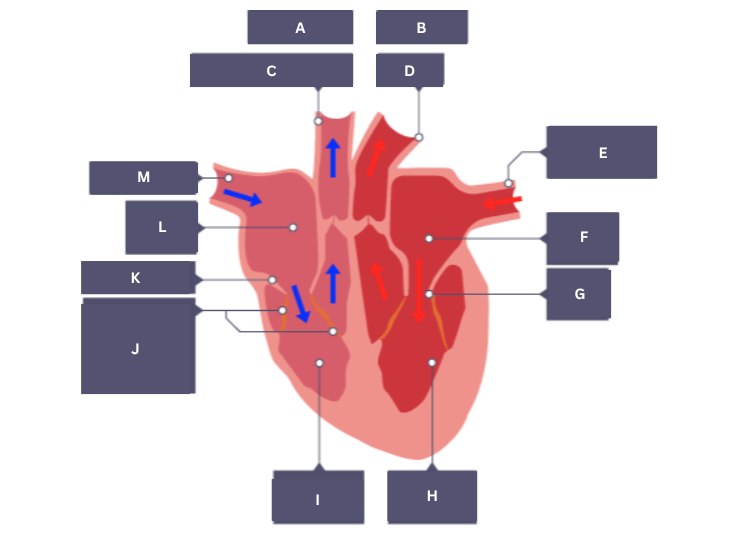
On this diagram of the heart, label G.
Heart valve

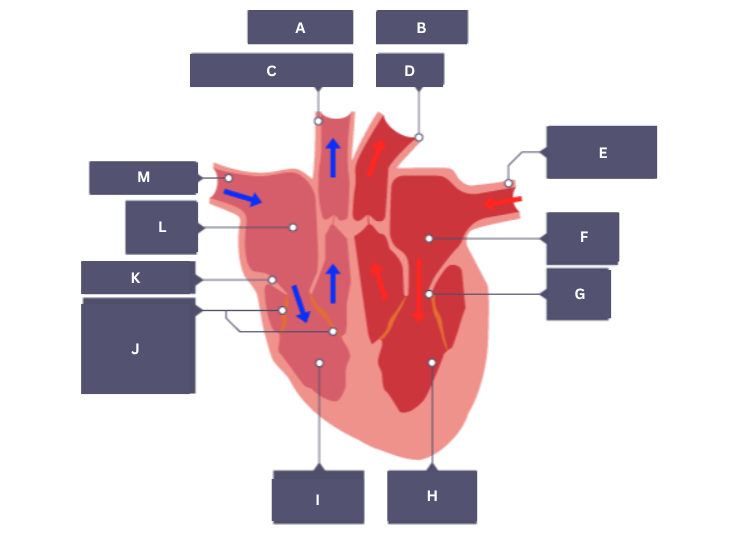
On this diagram of the heart, label H.
Left ventricle
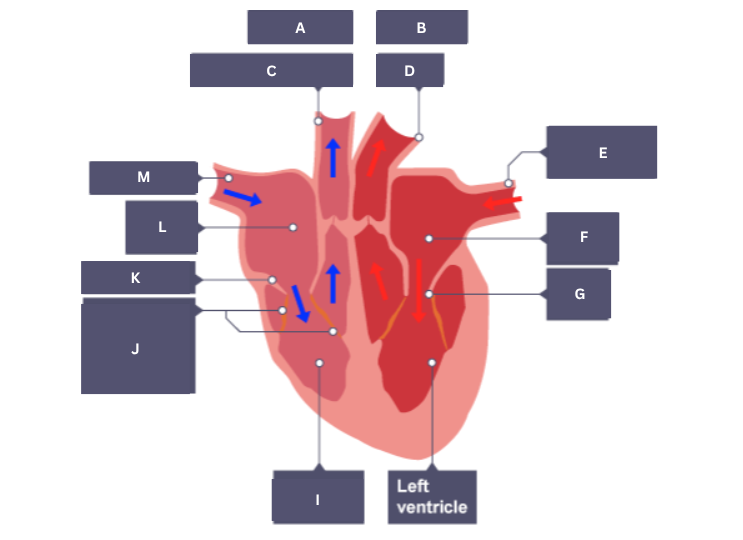

On this diagram of the heart, label I.
Right ventricle
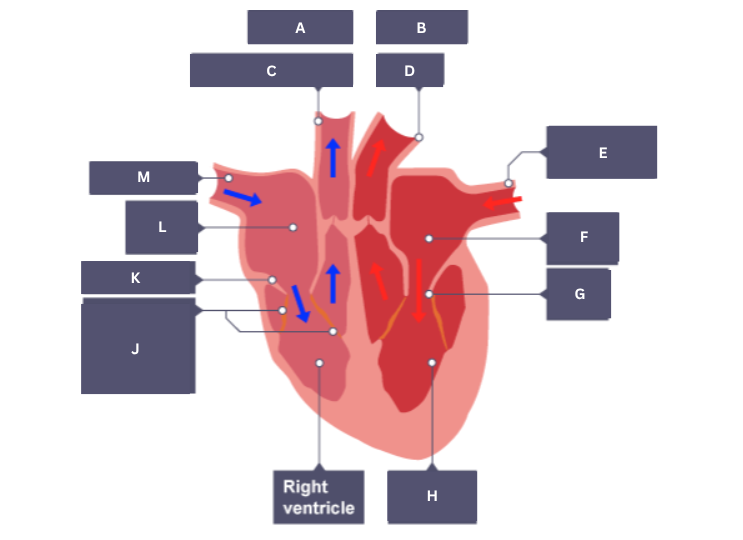
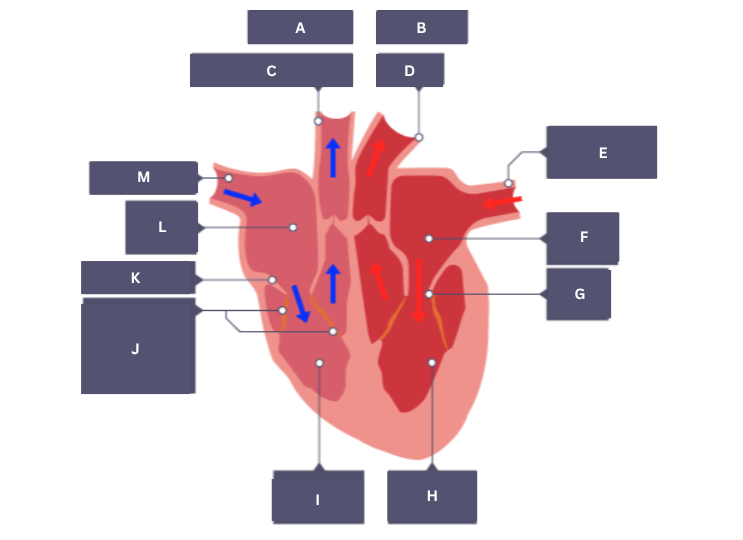
On this diagram of the heart, label J.
Tendons attached to valve and heart wall

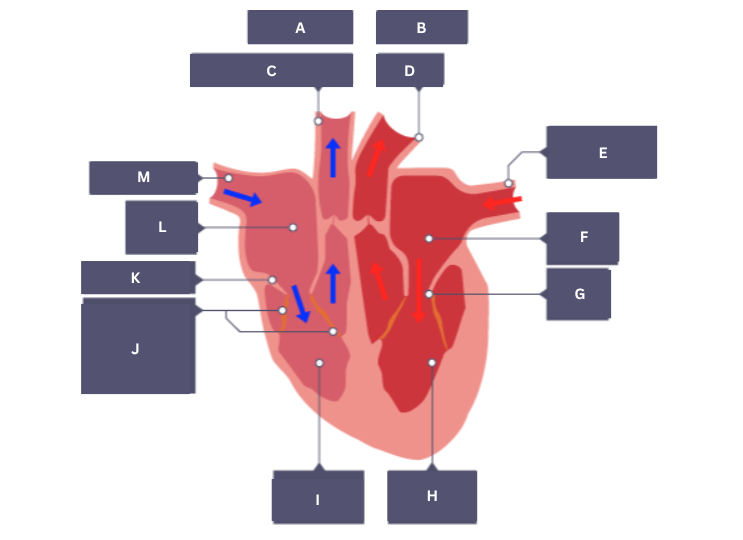
On this diagram of the heart, label K.
Heart valve
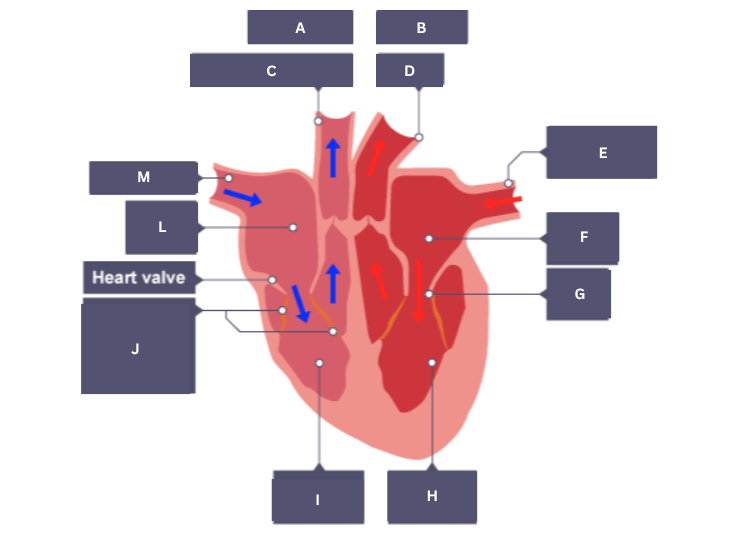

On this diagram of the heart, label L.
Right atrium
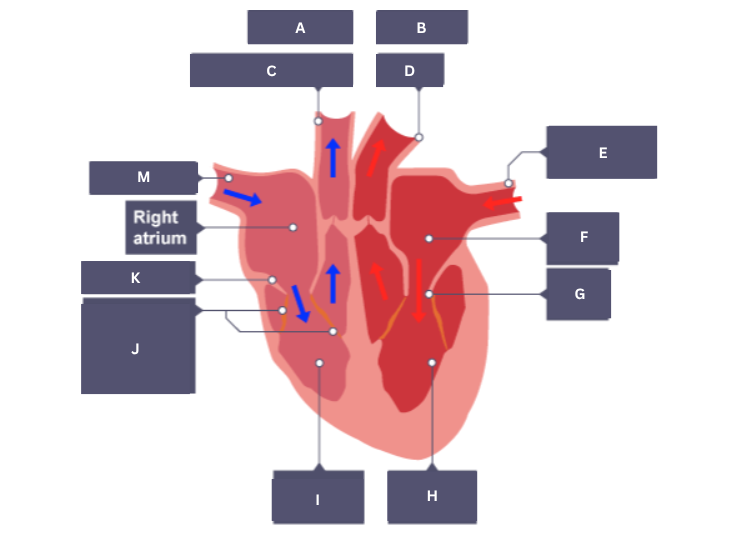
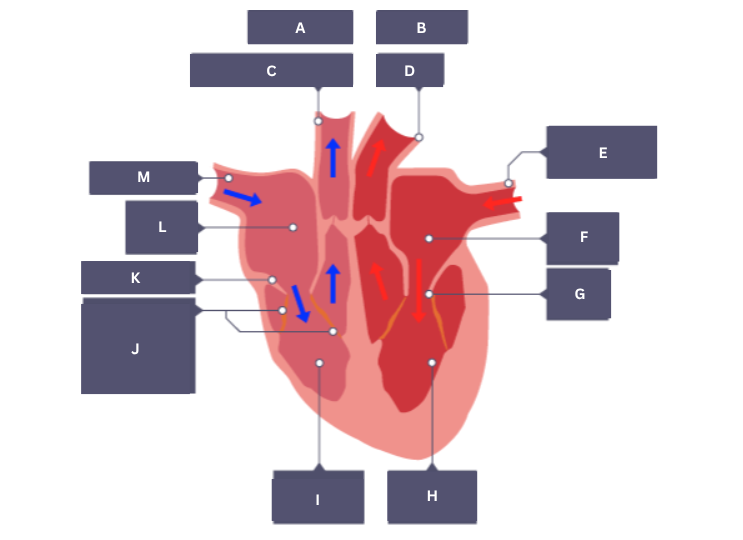
On this diagram of the heart, label M.
Vena cava

What is the purpose of valves in the heart?
Prevent the backflow of blood.
What is the purpose of coronary arteries?
Coronary arteries supply the heart muscle with oxygenated blood.
Describe the process of blood flow through the heart
Blood enters the right atrium via the vena cava, and the left atrium via the pulmonary vein.
The atria contract, forcing blood into the ventricles and causing valves to shut.
After the ventricles contract, blood in the right ventricle enters the pulmonary artery (to the lungs) and blood in the left ventricle enters the aorta (to the body).
What is the approximate value of the natural resting heart rate?
70 beats per minute
How is the heart rate controlled?
Heart rate is controlled by a group of cells in the right atrium which act as a pacemaker.
They release waves of electrical activity which cause the heart muscle to contract.
How can an abnormal heart rhythm be treated?
Irregular heart rhythms can be treated using an artificial pacemaker, which sends out electrical signals to correct the heart’s rhythm.
What are the three types of blood vessel in the body?
Arteries
Veins
Capillaries
What is the function of arteries?
To carry blood away from the heart.
How are arteries adapted for their function?
Thick muscle layer - adds strength to resist high pressure.
Thick elastic layer - allows arteries to stretch and recoil - in order to withstand high pressure.
What is the function of veins?
To carry blood towards the heart.
How are veins adapted for their function?
Wide lumen - enables low pressure
Valves - prevent backflow of blood
What is the function of capillaries?
To enable transfer of substances between the blood and tissues.
How are capillaries adapted for their function?
Walls are one cell thick - short diffusion path.
Permeable walls - substances can diffuse across.
Narrow lumen - blood moves slowly - more time for diffusion.
How would you calculate the rate of blood flow?
Volume of blood / number of minutes
Where are the lungs found in the body?
The lungs are located in the thorax (within the chest).
How are the lungs protected?
They are protected by the ribcage and separated from the rest of the abdomen by the diaphragm.
What tissues and organs make up the gas exchange system?
Trachea
Intercostal muscles
Bronchi
Bronchioles
Alveoli
Diaphragm
Explain how the lungs are ventilated by the action of intercostal muscles
Intercostal muscles contract
Ribcage moves upwards and outwards
Diaphragm flattens and volume of the chest increases
Increased volume results in decreased pressure
Air is drawn into lungs down pressure gradient. The inverse occurs when air moves out of the lungs.
Describe how gas exchange occurs at the alveoli
Oxygen diffuses from the alveoli into the capillary bloodstream down its concentration gradient.
Carbon dioxide diffuses from the capillary into the alveoli down its concentration gradient.
Describe how alveoli are adapted for gas exchange
Small and arranged in clusters - larger surface area.
Rich blood supply - maintains concentration gradient.
Thin alveolar wall - short diffusion pathway.
How would you calculate the breathing rate
Number of breaths / number of minutes
What substance carries the different components of blood around the body?
Plasma
What substances are transported by plasma?
Red blood cells
White blood cells
Platelets
Carbon dioxide
Urea
Products of digestion
What is plasma?
A yellow liquid within blood that transports substances around the body.
What is the purpose of red blood cells in blood?
Transport of oxygen around the body.
How are red blood cells adapted for their function?
Biconcave shape - increased surface area to volume ratio.
No nucleus - more room for haemoglobin to bind to oxygen.
Contain haemoglobin - binds to oxygen.
What is the purpose of white blood cells in blood?
They form part of the immune system, which protects the body from invading pathogens.
How are white blood cells adapted for their function?
Have a nucleus - contains DNA which codes for proteins
Can produce antibodies
Can produce antitoxins
Can engulf and digest pathogens (phagocytosis)
What is the purpose of platelets in blood?
Platelets are small cell fragments which aid the clotting of blood at the site of a wound.
Why is the function of platelets important?
Platelets aid in the process of blood clotting (conversion of fibrinogen to fibrin).
As a result, red blood cells are trapped in the fibrin network, forming a clot which prevents excessive bleeding.
Scab formation (after the clot has dried) prevents bacteria from entering the wound.
What is coronary heart disease?
Coronary heart disease occurs when the coronary arteries that supply with blood the heart muscle become blocked with a buildup of fatty material.
This restricts the supply of oxygen to the heart, possibly leading to a heart attack or death.
What is a stent and how does it work?
A stent is a metal mesh tube that is inserted into a blocked artery so that it remains open.
The stent is inflated using a balloon, which is later removed to allow blood to flow freely.
What are the advantages of stents?
Insertion can be carried out without general anaesthetic
Quick recovery time
Lower the risk of a heart attack
What are the disadvantages of stents?
Risk of postoperative infection
Risk of blood clots at site of stent
What are statins?
Statins are drugs which reduce the level of LDL (bad) cholesterol which contributes to the development of coronary heart disease.
What are the advantages of statins?
Reduces risk of strokes, coronary heart disease and heart attacks
Increase level of HDL (good) cholesterol
What are the disadvantages of statins?
Have to be taken continuously
May have side effects
Effect may not be immediate
What is a heart bypass surgery?
A surgery where blocked coronary arteries are replaced with sections of veins taken from other parts of the body.
What are the consequences of leaky heart valves?
Blood flows in the wrong direction, causing the heart to become less efficient.
Patients may become breathless and die as a result.
What types of valves can replace leaky valves?
Mechanical - made of metal or polymers
Biological - taken from animals (pigs, sometimes humans)
What are the advantages of mechanical valves?
They last for a very long time.
What are the disadvantages of mechanical valves?
You would need to take medication to prevent blood clotting around valve.
What are the advantages of biological valves?
They work very well - no medication required
What are the disadvantages of biological valves?
They only last 12-15 years
What is the purpose of an artificial heart?
Artificial hearts are intended to support a patient’s heart while they wait for a suitable donor heart.
What are the advantages of artificial hearts?
Less likely to be rejected by immune system
Allows damaged heart to rest to help recovery
What are the advantages of artificial hearts?
Risk of infection due to surgery
Risk of blood clots
Have to take blood-thinning drugs
What is health?
Health is the state of physical and mental wellbeing.
What is a communicable disease?
A disease caused by a pathogen which can be transmitted from one person to another eg. the flu.
What is a non-communicable disease?
A disease which can not be transmitted from person to person eg. cancer.